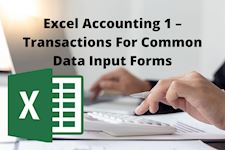Excel Accounting 1 – Transactions For Common Data Input Forms
Skill Success
Summary
- Certificate of completion - Free
- Tutor is available to students
Add to basket or enquire
Overview
This course includes lifetime access so you can complete it at your own speed.
Learn the basics of how to create an accounting system using Excel, starting from a blank worksheet.
Benefits of taking this course include:
- Unlimited and lifetime access to the course
- Learn the course at your own pace
- Course can be accessed on any platform
- 24/7 Customer support
Course media
Description
What you'll learn:
- How to create an accounting system using Excel, starting from a blank worksheet
- How to navigate and format Excel worksheets
- How to create a general journal, general ledger, trial balance, and subsidiary ledgers
- How to create financial statements, including a balance sheet and income statement
- How to enter transactions related to the vendor cycle, customer cycle, employee cycle - including the impact on subsidiary ledgers and financial statements
In this course, we will build an accounting system starting with a blank Excel worksheet, creating a general journal, a general ledger, a trial balance, subledgers, and financial statements.
For each new step in the process, you will have access to a downloadable Excel Workbook, containing at least two tabs, one with the answer, the new steps having been completed, the other starting out where the prior presentation left off.
Once we have created our accounting system worksheet, we will use it to record common transactions, entering the journal entries into the general journal, posting to the general ledger, creating the trial balance, adjusting the subsidiary ledgers, and constructing the financial statements.
As we enter each transaction, we will consider the data input often used in accounting software like QuickBooks. We will use data input forms like bills, invoices, credit memos, checks, sales receipts, and more, to simplify the data input process, allowing users with little accounting experience to learn data input.
Accountants are generally more valuable when they understand both the accounting theory, the impact on financial statements of each transaction, as well as how an accounting database program like QuickBooks works, including the data input forms used to enter normal financial transactions.
Because spreadsheets are so transparent, they are the perfect tool to gain an understanding of both accounting theory and accounting software.
Conversely, building an accounting system in Excel is a great way, one of the best ways, to improve your Excel skills.
COURSE CURRICULUM
Section 1 - Create Excel Worksheet
- Downloadable Worksheets
- 1025 Create Accounting Worksheet Part 1
- 1028 Create Accounting Worksheet Part 2
- 1031 Create Accounting Worksheet Part 3
- 1034 Create Accounting Worksheet Part 4
- 1037 Create Accounting Worksheet Part 5
- 1040 Create Accounting Worksheet Part 6
- 1043 Create Accounting Worksheet Part 7
- 1046 Create Accounting Worksheet Part 8
- 1049 Create Accounting Worksheet Part 9
- 1052 Create Accounting Worksheet Part 10
- 1055 Create Accounting Worksheet Part 11
Section 2 - Vendor Cycle, Purchases Cycle, Or Accounts Payable Cycle Transactions
- 1180 Bill Form
- 1200 Pay Bills Form Check
- 1260 Check Form
- 1280 Void Check Prior Period Adjustment
Section 3 - Customer Cycle, Sales Cycle, Or Accounts Receivable Cycle Transactions
- 1340 Invoice Form
- 1360 Receive Payment Form
- 1380 Deposit Form
- 1400 Sales Receipts Form
- 1420 Credit Memo Refund Form And Bad Debt Expense Service Item
- 1488 Credit Memo With Inventory
Section 4 - Employee Cycle - Payroll Cycle Transactions
- 1520 Pay Employees Form
- 1522 Pay Employees Form Part 2
Who is this course for?
- Accounting professionals
- Anyone who wants to learn Excel
- Students
- Business professionals
Requirements
- None. If you do not have Excel, you may use Google Sheets or some other spreadsheet program.
Career path
None
Questions and answers
Currently there are no Q&As for this course. Be the first to ask a question.
Certificates
Certificate of completion
Digital certificate - Included
Reviews
Currently there are no reviews for this course. Be the first to leave a review.
Legal information
This course is advertised on reed.co.uk by the Course Provider, whose terms and conditions apply. Purchases are made directly from the Course Provider, and as such, content and materials are supplied by the Course Provider directly. Reed is acting as agent and not reseller in relation to this course. Reed's only responsibility is to facilitate your payment for the course. It is your responsibility to review and agree to the Course Provider's terms and conditions and satisfy yourself as to the suitability of the course you intend to purchase. Reed will not have any responsibility for the content of the course and/or associated materials.


